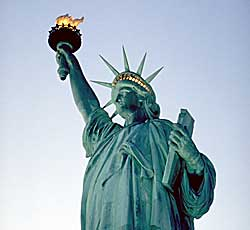 |
LITR 5731 Seminar in
Multicultural Literature American Immigrant Literature |
 |
|
|
|
|
|
narrative
narrative can be either fictional or nonfictional, something that happens in a story or in your own life or the history of a nation
Other ways of thinking about narrative:
journey with trials, setbacks, tests, ultimate success . . .
American Dream story, rags to riches
Old World > New World
Traditional culture > Modern Culture
Big families, connection / oppression > individualism, self-expression
Sometimes an expression of dissatisfaction with the American Dream or homogenized American identity, sense of loss with change
(for example, in poem, Grandfather spitting on floor)
2 upbeat fiction narratives ("Soap and Water" & "The English Class") representing generally sunny side of Immigrant Story / American Dream
“English Lesson”
22 Mrs. H < grandparents from Germany—poor immigrants, work way up
24 improve my position
25 in search of a better future
31 improving yourselves
31 [class as second immigration]
“Soap and Water”
107 clothed in shirtwaists I ironed—fashioning their pedestal (cf. “cleaning toilets” in “English lesson”
109 dreams of America > shattered > deathless faith
109 people in laundry, grudge against me, left them
110 tied and bound > untied, freed
immigrant story as one of opportunity
old world of oppression, inequality > new world of liberation, equality
Purpose of first two regular classes:
Establish the immigrant narrative
Overall question for discussion:
Can you isolate the same "immigrant narrative" or "American Dream" story across both texts?
What variations?
What are its attractions? What are its hidden costs?
What are the literary attractions or powers of this narrative? Why or how does it work for a reader?
2 upbeat fiction narratives ("Soap and Water" & "The English Class") representing generally sunny side of Immigrant Story / American Dream
“English Lesson”
22 Mrs. Hamma < grandparents from Germany—poor immigrants, work way up
24 improve my position
25 in search of a better future
25 classroom = America
31 improving yourselves
31 [class as second immigration]
“Soap and Water”
107 clothed in shirtwaists I ironed—fashioning their pedestal (cf. “cleaning toilets” in “English lesson”
109 dreams of America > shattered > deathless faith
109 people in laundry, grudge against me, left them
110 tied and bound > untied, freed
What are its attractions? What are its hidden costs?
In literature you don't just learn "affirmation" but "criticism."
Therefore we don't just celebrate the immigrant narrative, but we criticize it.
"Soap and Water"
109 people in laundry, grudge against me, left them
"English Lesson"
30 Rudi’s ambivalence re gender roles
30 x-help of man, dependent
Begin opening to the difference of the minority narrative
Larger purpose of course: not just the immigrant narrative but two other multicultural narratives: minority and dominant culture
Where does the minority narrative appear in today's readings?
“English Lesson”
27 NYC, ethnic groups > Dutch (x-Indians)
26 conflict between immigrants
“Soap and Water”
106 slavery [how true? Metaphor or fact?]
Summary: The immigrant narrative doesn't exist entirely independently of the minority narrative, but defines itself against the minority narrative: we-they, etc.
dominant culture
mid-20th century characterization of dominant culture
"WASP"
White
Anglo-Saxon
Protestant
Summary: The immigrant narrative doesn't exist entirely independently of the minority narrative, but defines itself against the minority narrative: we-they, etc.
Dominant culture moment
Objective 4. To identify the “dominant culture” (sometimes referred to as a “core culture”) to which immigrants assimilate, particularly in terms of class, ethnicity, gender or family life, and religion. In brief, this section of the course tries to answer, “What kind of culture do immigrants assimilate to?” . . .
See presentation schedule--last 3 meetings focus on "Dominant Culture Narrative"
Exodus story in Old Testament of Bible > Pilgrim story of early Anglo-Americans
Names or associations of dominant culture:
whiteness
Northern European descent and speech
earliest immigrants to North America, Germanic language
gender: masculine privilege, but European code of chivalry honors women
Most peculiar aspect of dominant culture:
subjectively: We recognize it, but we act like we don't. Difficult to talk about, partly because of class power--in a nation devoted to equality, "one way you can tell if you're American is if you can't talk about class"
objectively: the dominant culture is often marked by plainness, blandness, almost invisibility
Instructor's notes:
Response to Cheryl's presentation: dominant culture often appears as "gatekeepers"--who gets included or excluded?
"English Lesson"
22 Mrs. Hamma < grandparents from Germany—poor immigrants, work way up
23 tallest person
"Soap and Water"
105 Dean Whiteside
107 illusion of college
[college as class?]
A place where I didn’t belong
109 college, clothes > class distinctions
110 one from the clean world
demographics
classical purpose of literature: to entertain and inform
to engage and uplift
last class, ended on "demographic transition" but awkward at defining demographics
from Merriam-Webster's 7th Collegiate Dictionary
demography [< French < Gk demos or people + graphy or writing]
The statistical study of human populations esp. with reference to size and density, distribution, and vital statistics
Global vision of immigration demographics:
First world: Western Europe, Japan, USA (esp. "blue states," e. g., New England, Northern Midwest, California)
("modern society": gender equality, public education, free market + social safety net = middle class, secular government)
population: limited births, aging population, stable or declining numbers
Third world: everywhere else (e. g., Mexico, Africa, Middle East, most of India and China, + "poor states" of USA--Old Confederacy and southern Midwest
("traditional society": gender hierarchy, less support for public education, free market but fewer social services > rich and poor, mixing of government and religion)
population: unprotected sex; "family values" + higher rates of dysfunction, divorce, and separation; early childbearing by women